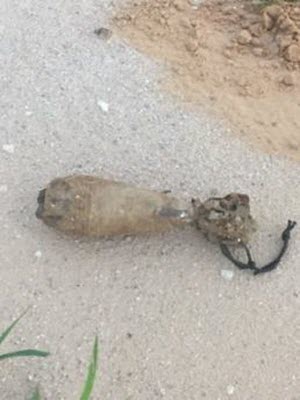Courtesy Story: 176th Engineer Brigade (TXARNG)
Posted: October 08, 2015
 Courtesy Photo
Courtesy Photo
Texas-based Army engineers unearthed an 81-millimeter mortar round during a multi-component range road project, July 12, 2015. Active-duty soldiers from the 79th Ordnance Disposal Battalion, 71st Ordnance Group based in Fort Hood, Texas responded and detonated the mortar using C4 explosives. The 17-mile roadway construction is a 25 day project, 6-30 July, along the perimeter of the Camp Bowie Training Center in Brownwood, Texas. (U.S. Army National Guard Photo Courtesy of 111th Engineer Battalion)
BROWNWOOD, Texas – A U.S. Army Reserve engineer soldier got more than he bargained for when he unearthed unexploded ordnance (UXO) while participating in a multi-component roadway construction project at the Camp Bowie Training Facility, July 12, 2015.
“I was grading down the road and I felt the vehicle shift a little,” said Sgt. Dwayne Goodell, horizontal construction engineer, 277th Engineer Company, 980th Engineer Battalion, 420th Engineer Brigade, U.S. Army Reserve (USAR), based in Camp Bullis, Texas.
Looking down the sergeant saw what caused the unexpected movement; his heavy equipment vehicle blade struck a teardrop-shaped green metal tube with fins. The object was a fully intact 81-millimeter mortar round. The highly explosive projectile is used by the military to destroy vehicles, structures, and equipment from a distance of three to four miles away.
“I saw the fins, and I was like, ‘here we go again,’” said Goodell. “The mortar popped up, it spun a couple times in the air, and then it hit the ground.”
Locating the mortar was an unmistakably-unnerving feeling for the combat veteran. And Goodell had reason to worry. UXO can remain dangerous for years, or even decades, after failing to detonate. Exposure to the elements can cause the explosives inside a UXO to destabilize, making it respond unpredictably to shock or impact.
Fortunately for Goodell, the round came to rest without detonating.
“I didn’t think it was going to go off, because of how long it had been here, so I stopped the equipment and got off,” said Goodell. “I got a good distance away and called the NCO that was with us, and then we did the UXO report.”
The Army has well-defined procedures for dealing with UXOs, beginning with safeguarding the area.
“I went down and set up a cordon, another Humvee rolled up with the NCOIC and he set up the outer cordon on top of the hill, so that we would have visibility over the area,” said Goodell.
Several staff personnel overseeing the roadway construction project reacted to the UXO find.
“I looked over at the battalion commander and asked ‘Sir, did he just say UXO?,’” said Maj. Ed Zook, operations officer, 111th Engineer Battalion, 176th Engineer Brigade, Texas Army National Guard (TXARNG).
“When the find was confirmed soldiers in the Tactical Operations Center followed protocol and called for an Explosive Ordnance Disposal (EOD) team,” said Zook.
“EOD soldiers are highly prized for their knowledge of explosives and munitions. Although we, as Army engineers, routinely deal with explosives, the EOD are the experts when it comes to disposing of ordnance quickly and safely,” said Capt. Michael Fellers, headquarters commander, 111th Engineer Battalion, TXARNG.
The nearest EOD team was located at Fort Hood nearly 100 miles from the Camp Bowie Training Facility. Unsure of how quickly the team would be able to make the trip, the 111th and 277th made preparations to keep the area protected indefinitely.
Fortunately, the active-duty soldiers from the79th Ordnance Disposal Battalion, 71st Ordnance Group (EOD) team were on the scene in about two hours.
“Response from Fort Hood was excellent,” said 1st Sgt. Lucia Estrada, 277th Engineer Company, USAR. “We appreciated the speedy arrival.”
When dealing with UXOs, the EOD teams have the option of disarming the ordnance or destroying the device. After viewing the mortar, the EOD professionals determined to detonate the mortar where it was found using C4 explosives.
After placing the charge, the EOD team joined Goodell on the hill several hundred meters away. The honor of detonating the mortar fell to the man who found it. Goodell triggered an M-81 firing device and was rewarded a second later with a thunderous blast.
“It was pretty cool,” said Goodell.
The 17-mile roadway construction is a 25-day project, 6-30 July, along the perimeter of the Camp Bowie Training Center. The multi-component project planned and led by 111th Engineer Battalion, 176th Engineer Brigade, Texas Army National Guard (TXARNG) included active duty soldiers from the 36th Engineer Brigade based in Fort Hood, Texas and U.S. Army Reserve soldiers from 420th Engineer Brigade headquartered in Bryan, Texas.